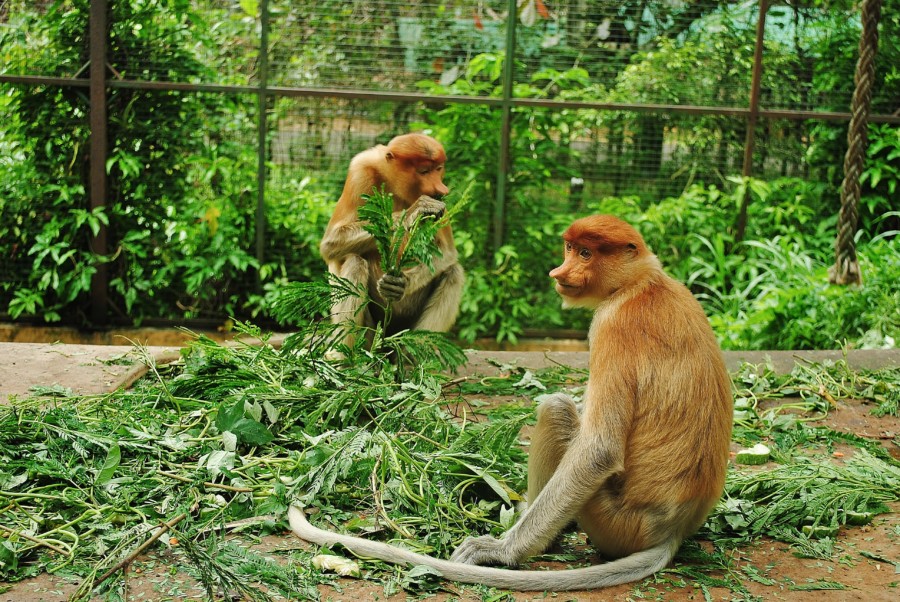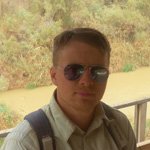Expedition to East Malaysia 2012
All travel reports are translated electronically although minor improvements are sometimes made.
Expedition to East Malaysia (Malaysian Borneo) 2012
Sarawak: Kuching, Bako National Park, Semengogh Orangutan Centre, Damai Cultural Village, Gunung Gading National Park, Niah National Park (caves), Miri, Lambir Hills National Park, Mulu National Park.
Sabah: Kota Kinabalu, Tunku Abdul Rahman National Park (Sapi island), Lok Kawi Wildlife Park.
(I’m going to complete my trip around Sabah on the way from the Philippines in the coming years. At least this is the plan.)

Hornbill is a species living on Borneo.
Apart from the places that I visited, this report includes a wealth of practical information, such as for example transport from one place to another.
The characteristic things about Malaysia:
►Malaysia is divided into eastern and western, and I assure that someone who was only in one part should not think that he knows all Malaysia well. Both parts are different not just because of nature but also economically and culturally. Traveling from Western Malaysia to East Malaysia is a completely new adventure.
►For clarification; In Malaysia there are many ethnically diverse peoples, but only Malay and ethnic Malays from Borneo are really Malaysian. Hindus and Chinese are Malaysian but not Malaysian, just as black or Muslim in Europe are not ethnically European.
►Malaysians are very proud of the natural beauty of their country and they have a lot to offer, and are confident that tourists will come back to them. After spending a month and a half in Malaysia I think they are right and have something to boast about.
►Malaysia is officially a Muslim country, although in the area of Borneo Catholics are the majority, and there are also Buddhists, Taoists and Hindus. Islam in Malaysia is described as mild although not as gentle as in Kazakhstan. There are still women and women bathing in clothes, but this is less common than in ultra-conservative countries. Citizens of Israel are excluded.
►Malaysia has in my opinion an advantage over neighboring Thailand, because the beautiful Malaysian islands are still empty while Thailand is crowded with tourists and very noisy. Here we can rest more from the people and closer to nature.

Exotic nature of Borneo during the rainy season.
Introduction
I’ve been to Malaysia before but it was too short and it was an unplanned stay. I arrived from Hat Yai (a small town in the south of Thailand about 3km from Malaysia). In 2012 I was well prepared for my expedition and spent a month and a half in Malaysia. I saw very well Western Malaysia and Sarawak state in Borneo, but this country has so much to offer that I have traveled more of the national parks than I had planned in the beginning. Sabah state I just started and I plan to see the Malaysian Borneo region in the coming years.
The Malaysian Borneo – short introduction
The Malaysian Borneo is divided into the states of Sabah and Sarawak and based on my experience it is a completely different country than Western Malaysia, although officially it is the same country. Malaysian Borneo is a beautiful, unique world of peculiarities of nature and special cultures. Malaysian Borneo is a wealth of deep jungles, the largest and deepest caves in the world formed in the original way and the world of beautiful waterfalls and natural warm pools. On the other hand, Malaysian Borneo is also a world of heat, high humidity and very annoying mosquitoes and leeches, but all these things do not matter in comparison with gorgeous views and interesting flora and fauna. The most interesting are the caves of Niah and Gunung Mulu, as well as the magnificent Bako National Park and its inhabitants, the proud Borneo citizen – long nosed monkey. They are cute !!! Also on Borneo we have the chance to see the orangutans in their natural habitat and to stay on beautiful, exotic beaches with great diving conditions. In the state of Sabah I can recommend, among other things, an expedition to Mount Kinabalu and the archipelago of Semporna. Borneo also has such wonders of nature as the largest country in the world – Rafflesia, and insectivorous plants. I also advise against warning signs of crocodile attack.
Finally, I will also give some practical information to the Malaysian Borneo. The population at such a big rally is about 1.83 million, and there are 24 ethnic groups: Iban (29.5%), Chinese (28.9%), Malay (20.8%), Bidayuh (8.4%), and others. Although officially Malaysian is an Islamic country in Malaysian Borneo, 29% of Christians, 26% Muslims and 17% of Taoist Buddhists live there. Borneo is a natural paradise where people live in harmony with each other and with nature.

Sarawak
Kuching
Kuching is a traditional entrance to Sarawak and its capital. For me it was the first Borneo town to fly to from Penang. Kuching (meaning “cat”) is an interesting, small city that crosses the river where colonial, Malay and Chinese buildings are located. Kuching is a very pleasant city. Living is mainly around the river near which there is a nice promenade with numerous bars, as well as restaurants and Chinese temples, located in small narrow streets. Kuching is also a city of many interesting museums, several parks and exotic vegetation. There is, of course, a large cat monument that repeats itself in souvenirs. Souvenir shops are always open in the evening, and the streets are also home to stalls with Malaysian burgers and articles that improve the sex life. The main mosque also has a pond, a bus station and a network of cheap shops and tea rooms. Kuching is nice and cheap and is also a great base for other interesting places.
From the airport at the nearest bus stop I got hitchhiked and then got an “ancient” bus to Kuching for only RM 1.50. I walked through several streets and park and got to the hostel in Chinatown. Bed in dormitory room with breakfast I paid only RM 20. In Kuching I spent some nice days and besides many attractions that the city offers, I also saw many interesting places outside it. On the first day I had to sleep a little, so I left for sightseeing in the afternoon. Within a couple of days in Kuching, besides the promenade by the river, I always see a lot of interesting places on the river, although Kuching itself and its monuments of cats are more tract.
All the Kuching museum are in one place, surrounded by beautiful natural scenery. These include the Sarawak Museum, the Museum of Art and the Museum of Natural History. It is also heavily advertised by the Government of the Islamic Museum, which is interesting but exaggerated in its content. In these museums we can admire, among other things, local art, traditional weapons and clothing, and remains of animals from Sarawak. There is even a skeleton dinosaur right at the entrance, and a skeleton of extinct crocodile-like reptiles, also in front of the entrance. All these museums are very busy and I would recommend them. Behind them there is also a very attractive aquarium. Among the exotic trees with richly branched roots fish and one crocodile are also in the tank. The museum is located on a hill overlooking the green area and a beautiful tree, unmatched in Europe. There is also a Textile Museum, which, as the name implies, is a showcase of Sarawak national costumes from the ages. Besides, I was often on the river and in Chinatown, I was in souvenir shops and in some Chinese temples. Right next to the river is an attractive white building and the Brooke Memorial and in its vicinity every weekend there is an open air market. Kuching is a pleasant place to explore and try new good dishes. I will add that on the other side of the river are two other objects: Astana and Fort Margherita, which in 2012 were closed for visitors.
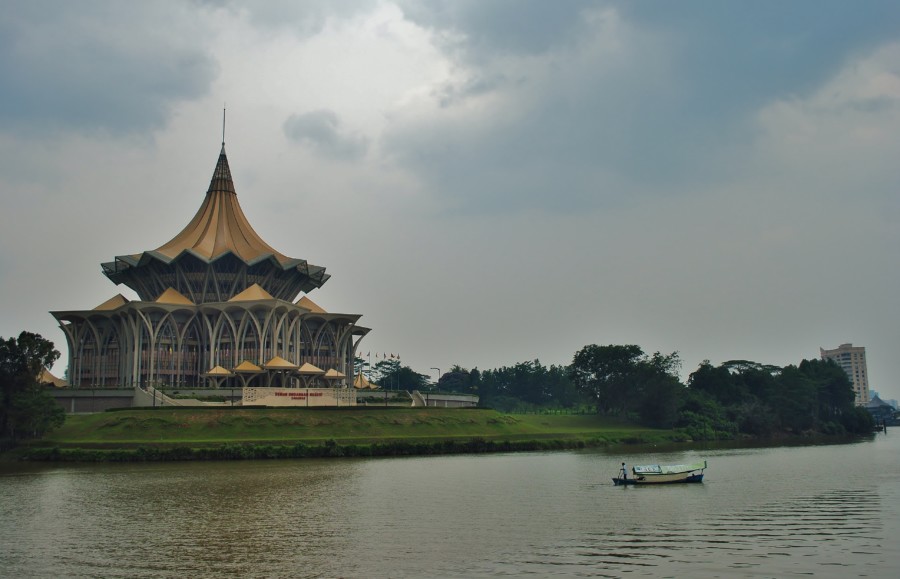
Semenggoh – The Orangutan Rehabilitation Centre
Semengogoh is a safe haven for our very close relatives – for the orangutans. The resort has a forest and specially arranged ropes and platforms for feeding. Tourists in this way can watch the orangutans. In Semenggoh there are not enough forests to call these conditions completely natural, but it is still the best that could meet orangutans in these very difficult times. Sam was witnessing when mom and her baby on the back took bananas and then turned on the tap with water to drink. Feeding is from 9 am to 3 pm. On the way back I was wet, but the whole Semenggoh center was a very educational experience that showed me the lives of these wonderful human cousins in conditions close to nature, for example without gratings and fences. Semenggoh is also much cheaper than a similar resort of this type in Sepilok, Sabah. For the entrance I paid only RM 10.
I got a local bus for RM 3.5 one way, and driving under the park gate alone takes 40 minutes. I advise to arrive early in the morning as the last bus return to Kuching departs at 1.30 pm. Then there is only a hitch or taxi.
In Semenggoh was a funny situation with two lesbians from England. One was a pretty blonde who smiled and the other was short-haired, had tattoos and a terrible look. When I tried to talk to the blonde her girlfriend immediately looked after her. Then in Kuching I spoke with two German boys who had the next day to share a boat with them to Bako Park, and they had a clever plan. They were going to sleep “babo-peasant” and get to the blonde. Poland wishes good luck!
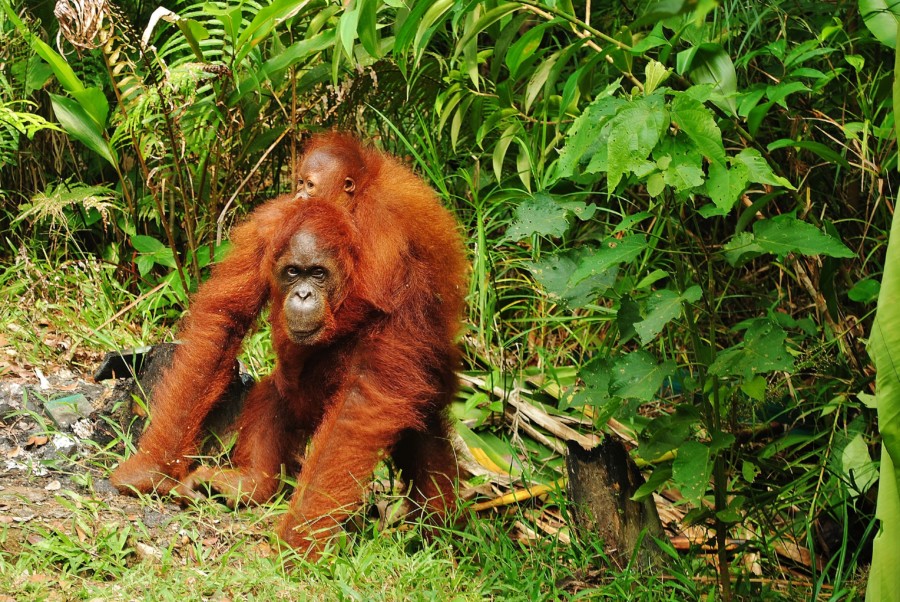
The Gunung Gading National Park
Another very good tour of Kuching is the Gunung Gading National Park, which is one of the smaller parks but still has very attractive trails full of exotic plants and beautiful waterfalls and natural pools. In Gunung Gading there are many beautiful trees with huge roots growing on the rocks and Malaysia’s most famous flower of the world – Rafflesia. However, I advise you to call the park first to see if any one is blooming. When I was in Gunung Gading, Rafflesia just started to bloom and in its shape resembled a large orange cabbage. On this day I did not meet other animals on two or four paws, so when I reached the waterfall I bathed underneath it naked in a natural pool surrounded by rocks. It was beautiful because I was surrounded by nature. There were beautiful trees covered with orange mushrooms, I saw some beautiful birds and rock formations, and naturally accompanied me with the sound of water. The time here is as much as I would recommend though I want to mark it to arrive in the morning.
Getting to the park is very easy. First I took the city bus for RM 1.5 to Kuching Sentral station, and from there I went to Lundu for only RM 12 one way. The ride lasted only 1.5h, and from Lundu to the park are 3km further, which you can go either for a taxi or an occasional hitch. I went in the heat 3km and on the way I broke up the papaya from the tree. Along the way there are a lot of them also recommended.
Th Bako National Park
(General and practical news, description of the natural beauty of Boko Park, my special experience with a couple of Chinese and a cheerful return by bus to Kuching)
Bako National Park is a large national park with many interesting trails and magnificent jungle and live animals. One of them is the longan monkey, which is one of the symbols of the island of Borneo although the magnificence of Bako Park could be exchanged for a long time. Bako is located on the coast of the South China Sea, and is located a short distance from Kuching and boasts of 37 mammal species, 184 bird species and 24 species of reptiles. In the park there are basic cottages for tourists and there are always wild pigs that roar in the ground near them. In Bako there are 17 different trails of different lengths and stages, and although you can hire a guide all the trails are so well marked that they can be crossed by themselves. A visit to Bako Park is advisable to reserve in advance, although it is not necessary. When I was here the cheapest bed in the dorm room cost RM 15.90, although the groups advise to reserve the whole house. With a boat there is never a problem.
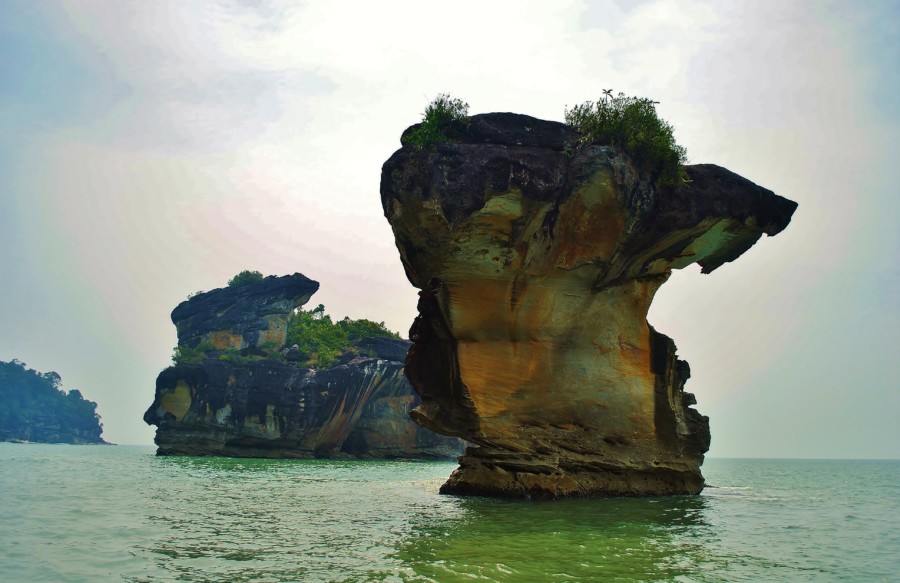
My adventure in Boko National Park was beautiful and this is what I did:
First I got on the bus in Kuching and after less than an hour I got to the Bako Bazaar in Kampung Bako. One way bus cost is RM 3.5. Then I went to the river office to order a boat to the park, but unfortunately I got here too late as it was at 1 pm and I had no one to share the cost with. The office was very pleasant; all of the wood, under the roof and also a wooden platform. To shore up many fishermen on their boats but none of them want to go to the park, so it is not worth asking. On the other side of the river there is a fishing village on the promenade, including a small mosque and many houses covered with dictation. My attention was paid to numerous posters and warnings about crocodile attacks. One poster depicted a man torn to pieces in the mouth of a huge reptile. At that point I was wondering if the guy who was doing this photo had any feelings. There was also a large crocodile skull on the table with his big teeth. The whole office was so nice, but there was also a thrill of emotion in pulling water and tearing apart. Returning to further transport, the only way to get to Bako Park is by boat, where renting costs RM 94 round trip. If you split the cost into four or five people it would not be a problem but for me it was too expensive. But luckily I got a smile on my face because after an hour of waiting a young couple from China came in. The boy boasted that he was very rich because he won a lot of money at casinos and therefore would pay for the boat and would pay for my room as he already rented the whole house in the park where there were two rooms anyway. Cool! Finally a poor traveler from Poland on a traditionally very, very low budget got something for free. Of course, I asked him if he wanted to pay me, but he always emphasized his wealth. He said he lost some money in Singapore but won a fortune in Macao. I was obviously in both places. So I only paid RM 20 for the park ticket, then we boarded and sailed. The driver of the boat did not hurry so we could admire the beautiful sea views, and then there were also interesting rock formations emerging from the sea and at the harbor forest of dried trees emerging from the water. During the cruise we talked a little but I started to feel awkward because the Chinese was so nice to me. She sat down beside me, wrapped my arms around me and told my boyfriend to take a photo of us. It was even more strange when they started talking in Chinese, and then he told me that on the way back for a free stay and transportation to the park asked me to take his girlfriend for a lonely jungle trip. What should I say? Of course I agreed, and the Chinese made another photo. Her boyfriend smoked cigarettes and said he was too tired to cross the park. However, she was not and could not wait. When we went to the shore in the park, first you saw a lot of monkeys sitting on the railing, and then going through the jungle on the wooden platform we headed towards the house. In this area, there was a lot of wildlife, though now the rather domesticated pigs, which eat the remnants of food. I could even say that I lived in a beautiful pigsty, because under my window, the black hairy pigs also slept, crunched and made interesting noises. The room was free of charge, and it was even good considering my very low standard, and its great advantage was that it was among the great nature. The Chinese lived next door. On the same day I went with the Chinese over the sea through the jungle to bathe in the sea. Chinese woman stood on the rocks and took pictures of me and her boyfriend sat on a bench and smoked cigarettes. We also crossed the bridge between tree trunks protruding from the water and the jungle. Standing here I saw a proud citizen of Borneo Island, or Proboscis monkey. It is a long nosed monkey that lives most often in mangrove forests with its characteristic long nose. Nature and a few other species of monkeys sitting near me were of course beautiful. That evening, after a pleasant walk and a sea bath, I strolled down the beach near interesting rock formations. I also chased wild pigs, which is always nice, until one was so tired that she lay down and stroked. Then I went back to my room but locked the key inside so I had to go through the window which required some work.
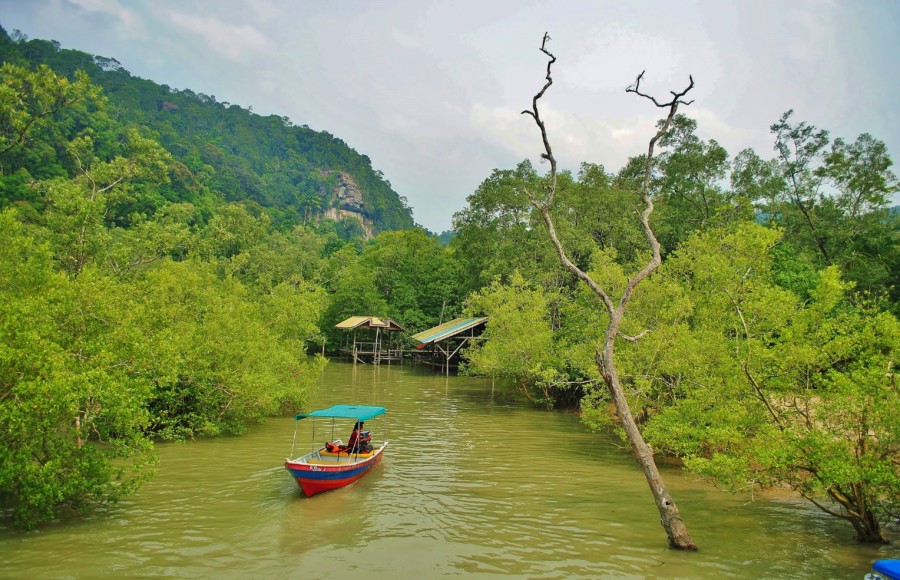
That same evening I went with the group to watch the jungle at night and I was able to find a green viper. The group was terrified the more because the snake was strongly venomous, but I took it on a stick holding the tail by the hand. Snakes are my passion. In my apartment, I have a few stingers in my bedroom, and while I was in India and Sri Lanka I trained with cobras. With the viper I had at that time the slightest experience. This trip cost RM 15, but if you want to save you can choose yourself under the condition that we have a very strong flashlight. Look carefully at the trees, leaves and cracks in the branches of trees as there is life everywhere.
The next day I went with Chinese woman for a day trip. It was not easy because we had to climb the tree roots, go through the jungle and the desert, but still she dressed in flip flops. We went Waterfall trail which is a multi-meter, very pleasant march through various parts of the park. At the end we stopped by a waterfall surrounded by wonderful exotic plants and a natural swimming pool, where I was swimming naturally. The water was pleasantly cold which gave relief from the heat and mosquitoes. At that time, the China girl photographed nature and I savored splendid water and environment. I met this guy from Canada who was good because at last I was able to get along without any problems. Then I came back with my Chinese woman the same beautiful way to the sea. The whole day was very good and nature was beautiful.
The next morning I boarded a boat with my boyfriend from Canada and the Chinese, and sailed to the park office. There the Chinese took a cab to Kuching and I with my companion went to fried rice in a nearby very low class pub. There was, however, a view of the river and the village on the promenades, the bowels of the fish on the shore and a very good chilli meal. I was sitting under a wooden roof eating money at the end of the world and I was very happy. Then we boarded the bus for only RM 3.5 and drove to Kuching. While driving, we were probably tired of the sun, but then we realized that we have to control ourselves. There were two beautiful women with us, and we and the Canadian were sitting far apart so we had to talk loudly. After a few epithets about their breasts and all the rest we realized we were in Malaysia where people speak good english. The Canadian just came from China where they spoke only in Chinese and I just stared blankly and commented. What a complete lack of manners on the part of a Polish traveler, although if the police stopped me was a documented British, so at least Poland would not be ashamed. By the way, two passports are a good thing. Depending on visa prices and immigration policy I can choose who I want to be. Polish passport is great because visas are cheaper and we have less on conscience. The Americans are the worst and most expensive.

I will add that it is good to take some food and drink to Bako Park because it is expensive.
The Damai Cultural Village
Damai is located on the coast called Peninsula Santubong and is a popular destination for wealthy tourists because they are the best hotels and rich houses of “greasy wallets”. There is also a nice beach, a golf course and some good restaurants. So the question is, what poor tourist like me doing in a place like Damai. There is also the Damai Cultural Village, which is an open-air museum. This village is a specimen of traditional, ancient houses built by the peoples of Sarawak, such as Iban, Melanau, Bidayuh and Orang Ulu. There are also Malay and Chinese houses. They are made of wood, have different shapes and heights, and their destiny depends on the culture of a given ethnic minority. You can also shoot from the special bamboo tube used to precipitate the monkeys with poison arrows. There are also a few shops under the whereabouts where you can buy local, natural products from people dressed in the traditional way. Houses (that is traditional longhouses) is a very interesting trip many centuries back, which I recommend. Finally, there was also a fun cultural show. After all, I was bathing in the sea.
To Damai, to the Singgahsana Lodge, surrounded by exotic vegetation, I got a bus ride from the Grand Margherita Hotel in Kuching (next to the cat monument) and the ride lasted about 45 minutes. For transportation in both directions with the entrance to the Cultural Village I paid RM 75. When I was here, ie in October 2012 there were no city buses and staying overnight in Damai is expensive. This is an interesting one day trip. Those interested can also take a walk through the jungle and visit the nearby fishing village of Kampung Buntal where there are several seafood restaurants.

Transport from Kuching to Batu Niah Nationa Park
From Kuching Central Bus Station I took a night bus going towards Miri. At first I planned to go to Miri to return to 115 km, but I thought it did not make sense, so I got off at the station near the intersection where there was a turn to the national park. Until that moment the ride lasted 14h and cost me RM 80. At the station they gave very good food and I recommend especially fish with rice in Malay sauce and vegetables. Then I went to the intersection, sat down on the road and grabbed a hitch. From the fork to the park gate is still 15km better for someone to stop. I was lucky.
From Miri take the bus 102 km to the road crossing towards Kuching, then the last 13 km by hitch or taxi. A little closer to the town near the park, called Batu Niah but no need to go there.
The Niah National Park (caves)
(A detailed Guide to Niah National Park)
115 km from Miri is one of the many natural beauty phenomena of Borneo and the world – Niah Caves. It is a small national park because it occupies only 32 km² and next to the fascinating caves in the Mulu National Park, Niah is one of the largest attractions in Sarawak. Outside the jungle and its beautiful nature, and the crocodiles living in the river, Niah caves are evidence of the existence of the first civilian living in these areas. Tourists usually come here only to see one cave, but I did a lot more. The entrance to the park cost me RM 20 and room RM 42 but I paid RM 20 because I shared a room with a Japanese.
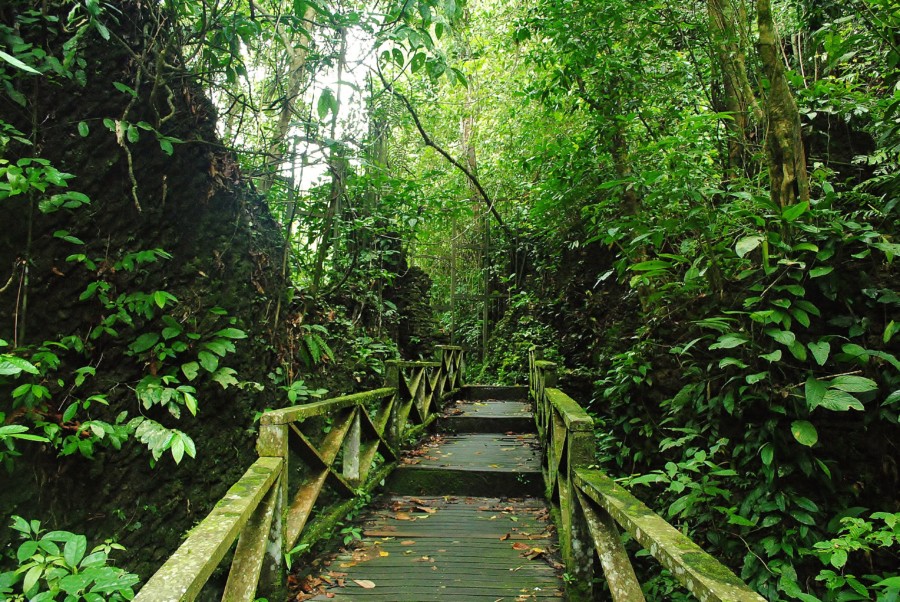
Day I – caves
On the first day I went on an 8km crossing through the jungle. First, I got into the boat by the river where there was a warning of crocodile attacks and then I went on my adventure. To the right was the Archaeological Museum, where I saw exhibitions related to archeology, geology and ecology of caves. It is also the last place where you can buy water and on the way back souvenirs. Of course there was a heat and a lot of humidity, so it was not easy in such conditions. Although a wooden walkway was built in the jungle, it was sometimes broken by a fallen tree. Besides the exotic wildlife hit that day there were three large caves which are the main reason for the arrival to Niah. First I went 3.1km to the Cave of Sellers, ie a huge open cave lying on the hillside. In this cave are interesting rock formations and the fact that it does not have one closed entrance. As for its size, I think it would fit in three tennis courts. Then I went another 1.4 km to the Great Cave, which was once the hideaway of the dead even 40,000 years ago. The great cave was huge, but to get to know its size, you should go deeper because there are some dark corridors, chasm and fascinating rock formations. All of this, of course, was accompanied by half a million bats and the stench of their faeces. The great cave is so huge that only its entrance is wide at 250 meters and the highest point is 60 meters high. Then the wooden stairs lead through absolute darkness, through the dark labyrinth to where we begin to see the light. On the way through the labyrinth heading down, where sometimes the ceiling is a little too low, you need a flashlight because you can not see absolutely nothing. What strange bats do not always see because one passing by collided with me.
Then I got to the Painted Cave, which is smaller but as the name suggests is attractive due to the paintings on the rocks. Painted cave is also not easy because for more ambitious photographers it is a good idea to climb the uneven terrain. Next, there is a high iron fence that separates us from the rest of the park. Usually when tourists see a large iron gate they immediately turn around. However, there is one missing piece in the gate, which, after a short climb, allows you to get to the other side. I did not regret that part of the park closed to tourists was also very interesting and adventure. Here the wooden road was often broken by fallen trees, and as it was a rainy season I had to descend to the jungle and again climb the existing road. I also stepped on the nail which was not pleasant. Then I walked through the jungle and watched the big trees with huge, tall boughs, the rocks wrapped around the roots of the trees, and occasionally the narrow tributaries of the river. It was great and it was very interesting, educational day but also very tiring. On my return I had to rest a little and go to the river to shine crocodile eyes, but I was so exhausted that I did not get up. I spent the whole night on the bus with Kuching, then took a hitch and immediately went on a tiring trip in hard conditions. Niah caves cost me a lot of health.
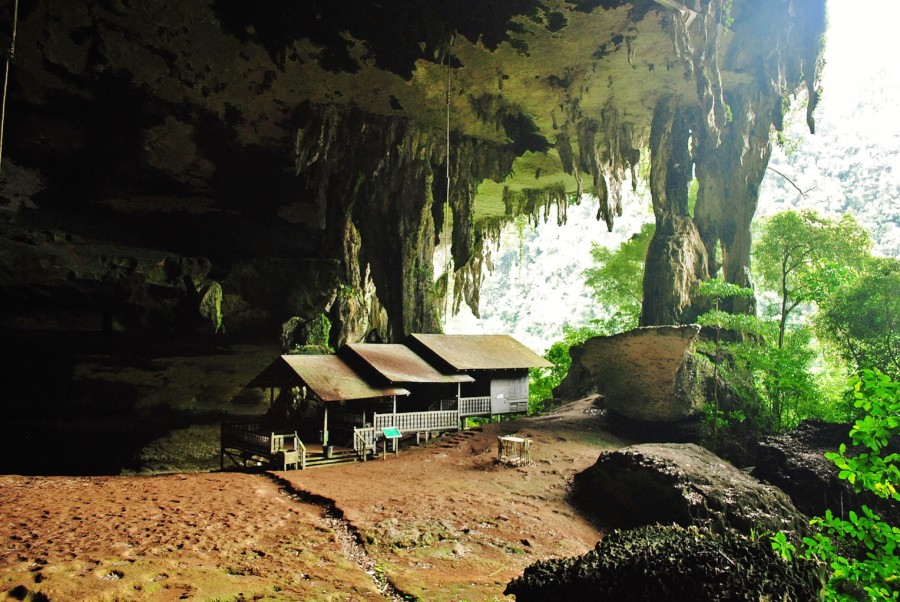
Day II – trek through the jungle and hike to Bukit Kasut
My trip that day was just plain easy. First I crossed the river and then walked for about an hour through the jungle. It was a pleasant walk in the damp heat and in the company of insects. The first phase was very easy, but then I reached the foothills of the limestone wall and from that moment it became more difficult. At first I went up the stairs, and at the very end I sat down with the people working there collecting bird nests from the caves. From what I know in the park Niah live 59 species of birds and one of them uses its saliva to produce nests that over time harden. Poor people climb the walls of caves without protection in order to gain these nests. Why? For Chinese, it is an aphrodisiac worth up to $ 2,000 per kilogram. They make soup and drink, despite the fact that each year the nest collectors fall off the walls and die.
Then my climb to Bukit Kasut started. Although the summit is only 205 meters high, it is a challenge for daring people who want to get to the top. I climbed the vertical walls holding trees, roots and crevices in the rocks. Later, I had help in the form of ropes and ladders attached to the vertical walls. There were many beautiful plants and rock formations on the trail, but the heat and the hard work of climbing meant that in those days, I attached more importance to not falling. After getting to the top I was mostly pleased with myself that I finally got there because it was not easy. At the top were interesting rocks and rock plants characteristic of Borneo. Some of them resembled conifers and other long cacti or aloes, but these were other species. There was a dense jungle and its high canopy, and Batu Niah, palm oil plantations, and the South China Sea at the horizon.
All the climbing was heavy and beautiful but I would not recommend it to anyone for safety reasons. There are easier places but they are also very difficult where the walls are vertical and the only help is sharp clefts of rocks and roots of trees. It is also important to stay on the trail, and when tired and in the heat you can easily get confused. For brave and confident, this is a great adventure.
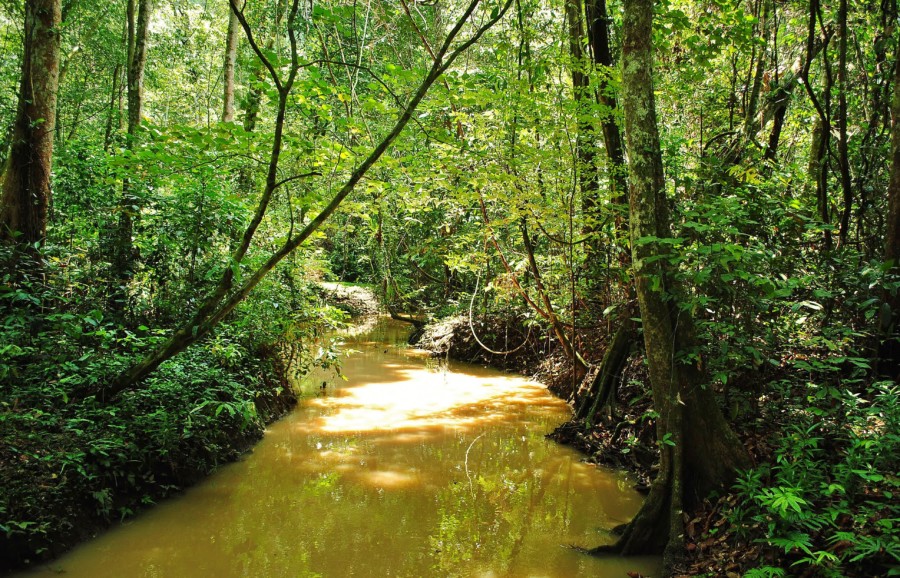
Transport from Niah do Miri
Firstly hitchhiking to the bus station where I ate something delicious and then a bus to Miri for RM 10.
Miri
Miri is a pleasant city located 123 km from the Sultanate of Brunei, which is close to many magnificent national parks, such as the previously described Niah caves. I stayed here in an inexpensive hostel called Minda Guesthouse where I was charged only RM20 for a bed in an air-conditioned dormitory room. Miri is very small therefore I went through them in less than a day. Although it is here so nice that you can spend up to two days, the best attractions are located outside the city. While in Miri I went to some interesting places but people not interested in visiting I recommend good food, some nice parks in the city and a discotheque in front of the hotel. While in Miri I went among other things to the tourist bazaar where I could buy souvenirs from travel, but it was unfortunately too expensive. Miri is unfortunately a little more expensive when it comes to souvenirs, because Brunei is quite close and a few tourists come. Then I was in a small pond with a pond and then went upstairs to see the Petroleum Museum. Apparently it is one of the best places to see the process of extracting oil. Outside there were some interesting expositions, but that day there was an exhibition of dinosaurs, which I have seen a lot. Then I went to the Tourist Center, which is a very good source of information when it comes to traveling in Sarawak. From there I went to the central bazaar Tamu Muhibbah, which is a good place to buy exotic vegetables. Another bazaar, clothing, and behind it is the Chinese temple of San Ching Tian, which is the largest Taoist temple in East Asia. In the evening, I walked around the city, sat down on a Malay snack and tied the mango straight from the tree. I will also say that the mango tree was in the mosque, so I had to do it under the cover of the night. Muslims prayed and I broke the mango while eating one or two. Then I washed my hands in their pool and left. But the mosques do come in handy.
To Miri many times I came back because it was my base for the surrounding national parks.

Transport from Miri do the Mulu National Park
The only way to the Mulu National Park which I recommend is the plane. You can also go to Mulu Park by boat, but this journey lasts forever and is more expensive. From Miri to Mulu there are small planes in which there are 50 seats and I advise to book myself on the internet for cheaper. At the office they wanted me to sell this flight for RM 350, while I paid RM 272. The flight should be booked at www.maswings.com.my and I recommend these lines as a quick and inexpensive way to get around Borneo Malaysia. With Miri you can get to Kelabit Highlands and anywhere else in Borneo. However, to avoid losing on the adventure I use the flights only when it is necessary. The flight from Miri to Mulu takes 0.5h and I got a drink on board. At the airport I got a bus to the main road, then a few kilometers on foot and hitch. I advise you to take some snacks with you. Mulu National Park is located about 110km southeast of Miri.
Mulu National Park
Mulu National Park is a world-wide natural phenomenon and one of the greatest natural resources. Park Mulu has original rainforest, unique flora and fauna and the world’s largest caves, one of which could accommodate about 15 football pitches. One of the caves is home to about 3.5 million bats. There are also wild cats and black bears in Mulu Park, but to see them at least one week into the jungle. One of the guides said that he has been working in the park for 16 years and the wild cat saw only once for about 2 seconds, so this park is recommended only as a unique beautiful place where we can admire exotic nature and breathtaking rock formations.
After a short flight I picked up the luggage and asked for cheap accommodation. Unfortunately, on a couple of nights one would cost RM 40 up to RM 200. But I got into the small bus for only RM 5 and the driver drove me to the gate of the park. We stayed in a private guest house for only RM 20. I do not agree with the fact that in this case the rooms should be booked in advance. Park Mulu is very popular, so it will be easier with cheaper accommodation every year. I was living on the river at home on wooden bales and on the other side were growing high canopy of Mulu Park. The landscape and silence of this place were soothing and I think it is also necessary for someone who lives in a big city every day. After a short while I went to register and pay RM 10 for entry. The entrance is cheap but then you have to pay separately for each trip, which makes the price increase after adding it. The entrance to the park led through a suspension bridge over a rushing river and in front of it was a small pub. Meal costed around RM 10 and the rest of the price was more exorbitant than at Miri. The office itself was decorated with the most beautiful nature pictures from Miri Park, and the ladies in the office were very helpful.
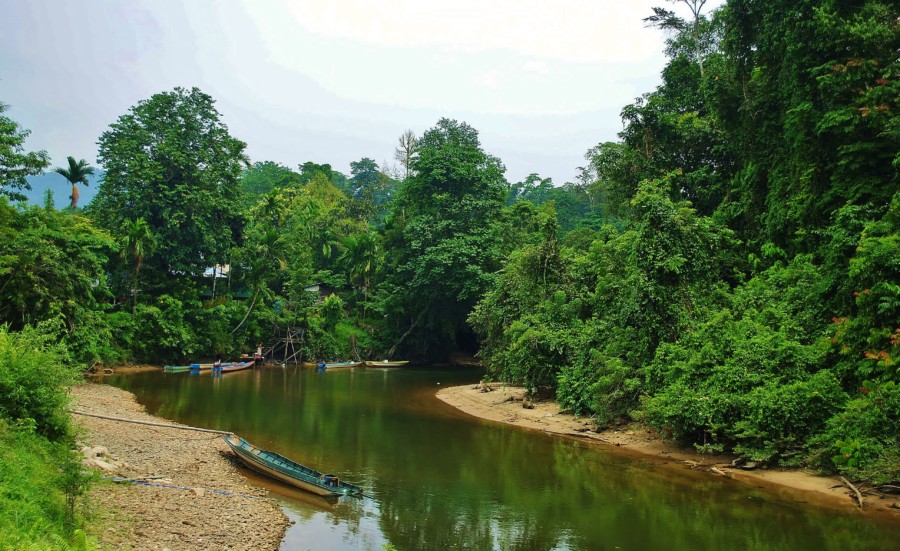
During my stay in Mulu Park I did the following trips:
►On the first day I went to the observation tower, which is located half an hour from the park gate. It is a multi-storey tower plundered with such animals as the hornbill bird or Borneo pride. Among the high canopies at the top of the tower, I hoped I would see these beautiful birds, but unfortunately I should have forgotten about it. I heard their sounds and fluttering of wings, but all jungle animals are masters of camouflage. This is a pleasant experience due to the nature and the observation of very tall trees on different levels. This pleasure is free. You only have to leave a refundable deposit of RM 50.
►Caves Deer Cave and Lang Cave. It was one of the most interesting trips, during which I first walked for about an hour through the jungle and admired the huge trees and their massive roots.
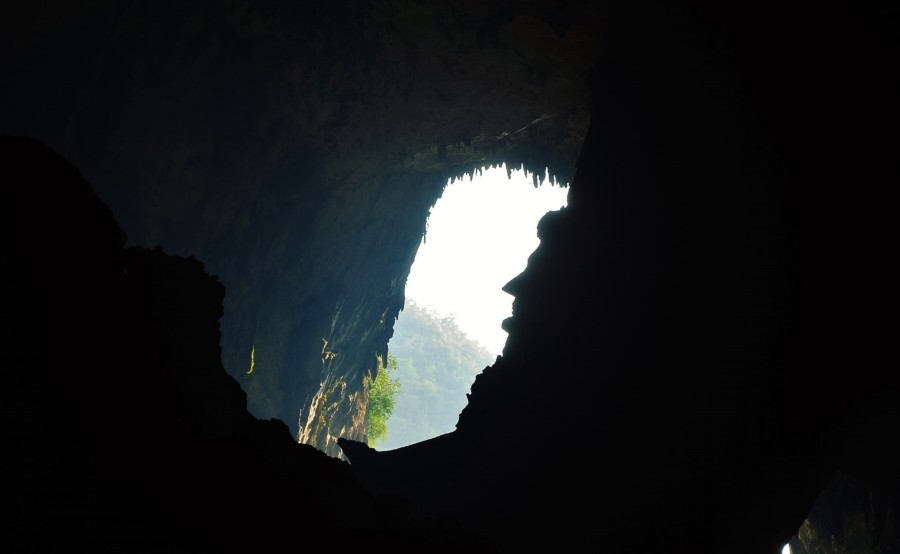
Mulu National Park – Malaysian Borneo. Please pay attention to the famous rock formations in the shape of a face of President Lincoln.
Deer Cave is one of the biggest attractions of the park and one of the largest caves in the world. This cave is 174m wide, 122m high at its highest point and over 2km in length. This cave is very strongly associated with the geological past of Borneo because the limestone cliffs are built inside as a result of compressed sea shells and further developed in the resulting lagoons formed by coral reefs. To realize the enormous size of this cave, unfortunately, my description of a few pieces of information is not enough, because it is such a powerful creation of nature. In addition, the cave passage is at different levels. In contrast, rainwater coming in through small gaps causes the calcium rock to crack and form into different shapes, which further deepen the cave. At the bottom is also the river, which also deepens the Deer Cave and connects it in this way with the Lang Cave. To this all Deer Cave has two very important elements. One of them is a rock formation in the shape of Abraham Lincoln’s head and the other is about 3.5 million bats flying out of the cave each day. There is also an observation point from where you can see them.
Another cave on the same trip is Lang Cave, which is another show of “cave architecture” at its best. Lang Cave is not so big but is very interesting and is located next to the Deer Cave and bat observatory. Entering the concrete and then on the wooden floor we can see the illuminated limestone rocks in streamlined shapes. There are massive stalagmites and stalactites, and fine rugged rocks on irregular ceilings. Lang Cave is wet because all the time the water flows down to it. Unfortunately, the only bad point about the program is that as it always happens in caves it is too dark for sharp pictures.
Deer Cave and Lang Cave can be seen on one trip for only RM 20.
►On the same day late in the evening I went on a lonely walk along the Botanical Road Night, as it is called in Mulu. I walked a small path between the trees and watched the nightlife. It was very interesting because at night the jungle is completely different. This attraction is free.
►The next day I went on a trip to see the Clearwater Cave and the Cave of the Wind. This trip was very interesting because we first had a long, narrow boat and sometimes we scrubbed the bottom. First we also stood in a small village for small purchases made of bamboo and shell backpacks and shell necklaces, but apart from seeing these very interesting items nobody bought anything. Then we boarded the boat again and continued our adventure speed boat trip until we reached the Wind Cave. Here we walked on the wooden stairs because the entrance was at a certain height. Wind Cave is famous for its interesting rock formations and fresh breeze and wind (hence the name). Wind Cave is so unique because here stalagmites and stalactites are in the form of thin, vertical columns. Next to it is the Clearwater Cave, another beautiful cave with clear turquoise water. Through this cave flows an underground river, whose waters get out. This means that the mirror of clean water surrounded by rock formations gives a beautiful cave effect. Swimming is not allowed here but there is crystal clear turquoise water in which I swam for some time. It was my favorite place that day. Especially considering the heat and the rainforest environment, swimming in the cold water was very refreshing. Then we went back to the park gates by boat. The whole tour cost RM 50.

►In the evening I went to the Paku Waterfall. It is located about an hour from the park gate towards Deer Cave. The path to the Paku waterfall leads through the jungle along the river. At one point on the right I saw a small waterfall, so I entered the river on the clay. I was swimming here under the rocks and from time to time I had a shower under the waterfall. The time here has passed me miraculously, because Paku is another very close contact with nature …. free of charge.
►On the day of departure I did the Canopy Walk. It is a rope bridge suspended on very high canopies and this one in Mulu Park is the longest in all of Malaysia. A walk at least 30m above the ground on a swinging bridge is a pleasant experience. The whole trip takes about 2h and costs RM 35. It is priceless considering that the canopy is only over half an hour but it is the only one in its kind. (The same attraction only shorter is also in Taman Negara Park in Western Malaysia).
Mulu National Park also has many other attractions that are being run by a very small number of tourists. Some of them are advanced caves requiring specialized equipment. These expeditions are available but they are also much more expensive and require a permit from the park manager, and the number of participants is always limited. There are several popular trails in Mulu Park, such as Gunung Mulu (2376m n.m.p.m.) and require strength, endurance and fitness. Other trails include the Trail of head hunters and the view of the high, sharp peaks known as the Pinnacles. These tours, however, range between RM 600-800 and take up to a week. So the options in Mulu are very many, many of which are persistent with thicker wallets.
I think that the Mulu Park is unique, deserves special attention and there is still a lot to discover. Mulu is beautiful and a visit here is a must for all travelers in Sarawak.

Lambir Hills National Park
Lambir Hills is a relatively small park, but in spite of its 6952 hectare area, scientists have found the greatest natural resources. This means that despite its small size, Lambir Hills has the most exotic species of plants, but also 237 species of birds, many species of monkeys, wild pigs and flying squirrels. Walking through the magnificent rainforest, I reached beautiful waterfalls and bathed in their natural pools. In addition to the high humidity and warm climate around me, of course, tropical nature and the jungle speaking its own language. Sometimes I also encountered traces of animals but never myself. I spent a lot of time bathing under waterfalls, but I climbed to the top of Bukit Lambir Park, which is 6.3 km from the park gate. The approach is heavy because the area is not easy, and the last 800m is very steep, which with great heat and humidity shoots. The view from the top is obviously beautiful, but not most have the strength to admire. One of the waterfalls is near the gate, and the ones I saw are the waterfalls of Latak, Dinding and Pantu.
Lambir Hills is only 30 km from Miri. I was lucky because I was hitchhiking on both sides, which saved me RM 40. Buses regularly go on this route. The entrance costs RM 20 but I paid RM 10 because I asked for a local ticket. Interestingly, on my way back to Miri, a manager of Lamir Hills Park (the young, short-legged kitten in a short skirt) stepped over me. She set me up early because she was afraid of a stranger in her car after dark, but it was only me, so she was safe. I politely thanked and left, and she said “miau” for the show.
Transport from Miri to the Sultanate of Brunei
First hitchhike from Miri center to bus station and then coach to Brunei. Bandar Seri Begawan (BSB) journey took 4h and the ticket cost RM 40. Brunei border crossed four times in different places and each time it was easy and without problems.
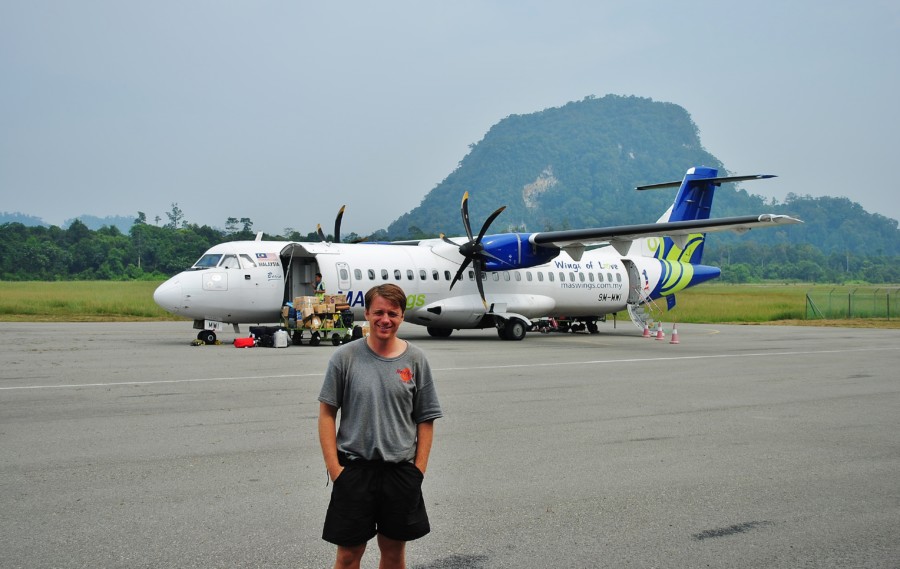
I recommend my full report and practical information about Brunei.
Transport from Brunei to Kota Kinabalu (KK)
This part of my expedition was a real adventure in transport;
From the center of Bandar Seri Begawan I took the bus to the port (25km, $ 1) and then sailed to Malaysia’s free zone on Labuan island. That day was too late for direct boats to Kota Kinabalu, so I took a small motorboat to Menumbok (RM 15, 20 minutes), a small transport hole already in Sabah state. With Menumbok I took the coach (RM 14, 2h) to Kota Kinabalu. While driving I drifted to my head but arrived quite fast, and during this part of the transport accompanied me a pleasant chaos and relaxation of the developing country.
On my way back to Brunei I sailed directly from Kota Kinabalu to Labuan Island (RM 31, 3.5h) where I stayed all day and one night. During ferry transfer I advise you to do two things: prepare a warm sweater because the air conditioning is tailored to the needs of polar bears, and take the film itself as the crew has some good but most are very stupid American productions.
Sabah
Sabah state is a tropical paradise of Borneo island, with a dense jungle, many beautiful animal species and Mount Kinabalu’s highest peak Borneo. In addition, Sabah has many beautiful beaches and coral reefs in turquoise waters. Sabah is also the land of orangutans, sea turtles, long-nosed monkeys, colorful birds and reptiles, all at about 40ºC. To sum up, Sabah is a tropical paradise where you can enjoy the wonderful nature, even if you take off the exotic fruits straight from the trees.
(In 2012, when I got to Sabah, my trip was over. I can say Sarawak is very good but Sabah has just started.)
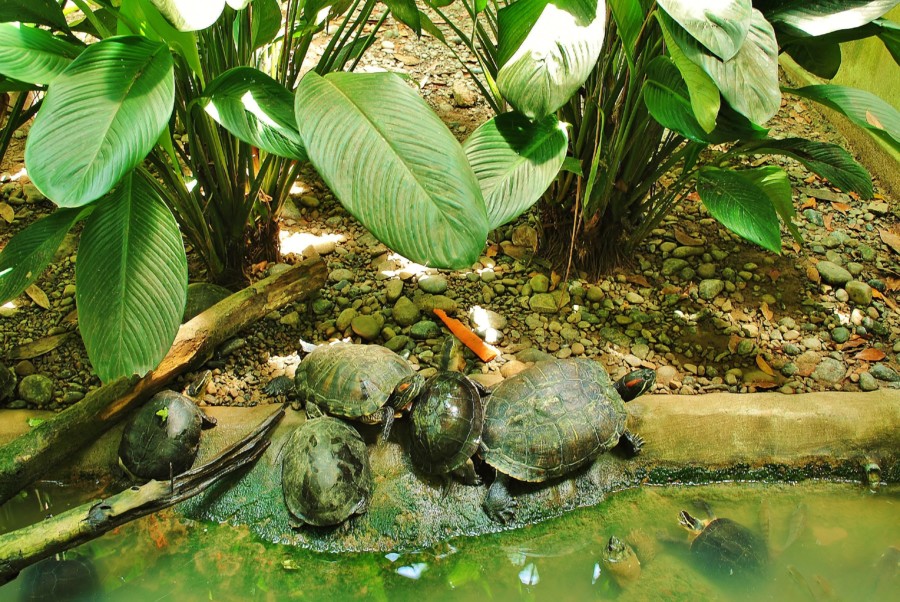
Kota Kinabalu (KK)
Kota Kinabalu is the capital of the state of Sarawak, although many believe it is also the capital of all Malaysian Borneo. Western Malaysia can boast Kuala Lumpur, while East Malaysia can not boast of Kota Kinabalu which does not mean it is not a very pleasant city. Kota Kinabalu does not have breathtaking monuments or architectural achievements, but on the other hand some do not come to Borneo due to art. The city has its sad past as it was twice destroyed during the Japanese invasion and twice rebuilt by allies. Today Kota Kinabalu is a very pleasant, peaceful corner of the world lying on the sea where it is close to many natural beauty attractions. Next to it is the Tunku Abdul Raman National Marine Park and the Lok Kawi Wildlife Park. In Kota Kinabalu there are many cheap hostels within RM 20-25 per bed and what you can especially recommend in this town is local food. Kota Kinabalu is filled with many attractive outdoor restaurants. Every evening at sea, the fishermen break the tables and sell their catch, which is exceptionally delicious and exotic in Borneo. In the city there are also many Chinese pubs where I especially recommend chopped chicken breast with rice, cucumber and soy sauce. Of course, green tea is necessary. I picked up Kota Kinabalu as a very nice little town, with massages, good meals and great nature at your fingertips.
I will give you more advice. Immediately after arriving in Kota Kinabalu (KK), you should immediately book climbing on Mount Kinabalu. There is one office where you can reserve and pay for the whole trip. At Kota Kinabalu I recommend two days and the next two for the nearest natural beauty, although an extra day would certainly not hurt.
Although the city itself is the biggest attraction in spite of this I have seen some interesting places. One of them was the Sabah Museum, which is an ethnographic museum and a museum of natural history Sabah under one roof. There is a whale skeleton, wedding dresses and ceramics from Sabah. Outside is a very nice park with a pond where traditional houses (longhouses) are built. In the second building is the Sabah Art Gallery where there are some interesting paintings and sculptures created by Sabah artists. The museum that gave me the most to think was the Museum of Islamic Civilizations, which in my opinion is funded by the Malay government for propaganda purposes. In this museum I learned about the migration of Muslims over the centuries and there was also a very interesting ethnic division of Muslims from many Islamic countries. Everything was fine until I saw a picture of a Muslim with a bag on his head and a signature: “British Muslims.” Yes, unfortunately they have reached Europe too. In one of the museums, the guard had a short conversation with me and told me that Poland was governed by Germany. From the hill on which the first museum is located I also saw the National Mosque, which definitely did not impress me, but I took a few pictures and went inside to wash in cold water. It was hot even a mosque to something useful. I liked the Central Bazaar connected with the Souvenir Market. In one spot on the seafront, on Jln Tun Fuad Stephens Street I found many interesting souvenirs sold by nice Muslims. Apart from many interesting souvenirs and good fruits, I also wanted to check out the Islamic sense of humor. Their heads were slightly wild at the sight of the White Man, but after a while I managed to get a smile out of some of them.
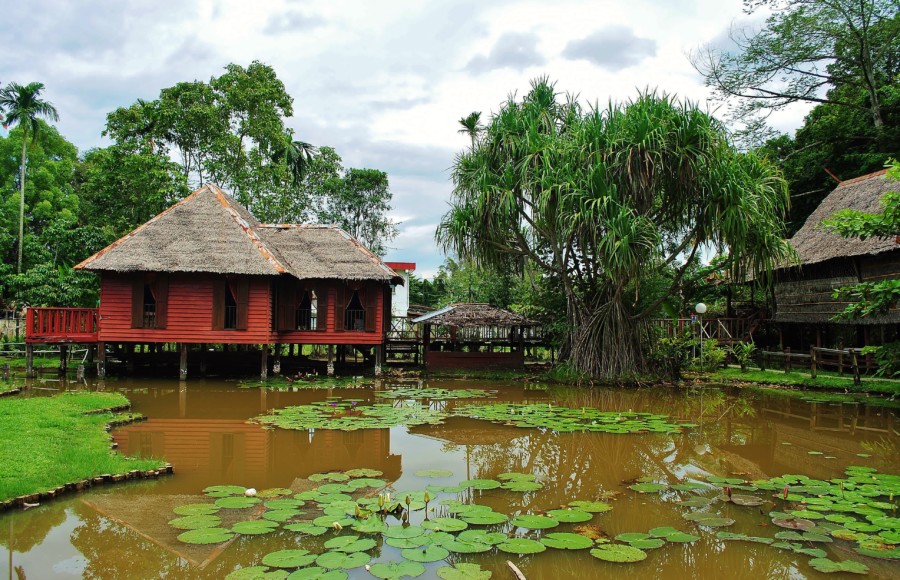
Kota Kinabalu I do recommend.
Tunku Abdul Raman National Park
Abdul Raman Marine National Park is a pleasant escape from the noise of the city. This park covers only 49km² and consists of five exotic islands, full of vegetation, nice beaches and clear turquoise waters and coral reefs. I went to Sapi Island where I spent the whole day with my french friend. It was very nice. We took a bath, went to dinner and went to a small island trip. On the island of Sapi there are several steep cliffs, beautiful views and traverse beaches. A big attraction for me was the presence of great warriors who were walking slowly on the island and occasionally entering the sea to take a bath. Of course I do not advise them to touch because these reptiles are not intended for stroking. Even their presence near people is not a danger. At the end of the day I jumped to the sea from the pier and a group of Chinese people took pictures of them. My stay here was very pleasant and my travel companion went with me for dinner after returning to KK. I would recommend the island and encourage you to stay at more than one.
Getting to any of the islands is very easy and cheap. Boats depart several times a day from Jesselton harbor, which is about a 10-minute walk from the promenade with a monument of great fish. Motorboat travel takes about 15-20 minutes and a return ticket to one island costs RM 17. After arriving to the island you should also buy a ticket for RM 10. I do not recommend buying organized trips that are very expensive and make the tourists feel like a herd of pioneers. This park is charming and you should enjoy it at your own pace.
Lok Kawi Wild Animal Park
Park Lok Kawi is a popular meeting point for families, but unfortunately it does not have to be slow running animals. This is a very nice, well organized and clean zoo. I saw here tigers, interesting buffalo with big horns and elephants. Unfortunately, when I arrived here there were no orangutans on the runway but luckily there were long nosed monkeys (Nasalis larvatus), one of the symbols of Borneo Island. I was also disappointed by the small presence of reptiles. For children I recommend performances with animals such as snakes, orangutans and monkeys. There are competitions for the first person to pick a coconut, and unfortunately the monkey always wins. This park is recommended especially for families with children.

I got there by small bus for RM 3 and then I hitchhiked. The distance from the bus station was 16km, about half an hour. Entrance for adults is RM 20.
Return to England
In this place after 4 months of travel my trip officially came to an end. From Kota Kinabalu I took a ferry to Labuan Island and then after one night I sailed to Brunei’s Suwanee. From there I took a flight to Kuala Lumpur during which I met a beautiful Muslim (with an open head and a pretty bust). She traveled with a more conservative mother, but Malajka’s young beauty kept hugging me at the airport and invited me to a meeting in Kuala Lumpur. What a peculiar fate, I thought. My trip could have been so happy ending here and unfortunately, in two hours I had a plane to Bangkok, which I already knew so well. Of course, in Bangkok I did not waste time. I had a little fun and the next morning I flew to England. The trip was beautiful and the people I met were nice too. All the countries I visited during this trip were beautiful. Unfortunately, as soon as I returned to London I saw a whole flock of black men in the subway, with a big lip, broad nose and a dull look. I thought it was hard because I preferred Malay jungle and nice Indian monkeys.
